How To Create A Terms And Conditions Page
The Terms & Conditions (T&C) are also known as Terms of Service or Terms of Use. This article and outline will help you draft and write a basic yet complete Terms & Conditions for your app or website.
The Terms & Conditions act as a contract between you and your users so you can control liability, manage use, protect your intellectual property, and enforce rules. While it's not legally required in any jurisdiction, it can make managing your website or app much easier.
Before You Write the Terms & Conditions
Before you write the Terms & Conditions for your app or website, understand why you need it and what you hope to accomplish with it. Otherwise, you're unlikely to create a complete agreement.
Understand Your Reasons
A Terms & Conditions agreement prevents users from abusing your service (or other users of your service), limits liability, and establishes any ownership in your trademarks, content, copyrights, and other intellectual property.
If you do not address these reasons at a minimum, you will limit your legal enforcement powers and claims against users.
As you write your Terms & Conditions agreement, keep these reasons in mind. It will help you avoid adding unnecessary material and help keep you focused.
The rest of this articles addresses specific clauses that help you protect your interests.
Set Your Ground Rules
You likely have rules for the usage of your app or website. For example, if you run a photo sharing site, you may prohibit sexually explicit material from being uploaded and shared on your site.
There may be age limits on who uses your app or website and those need to be enforceable, too. Some websites and apps require payment of subscription fees.
Make a list of any limits and rules regarding your website or app. You will work these into your Terms & Conditions agreement when you draft it.
Decide Agreement Location
Once you finish your Terms & Conditions, you need to post it in a conspicuous location.
On websites, the Terms & Conditions should be accessible through links. Many companies post links to the Terms & Conditions throughout their website pages, usually in the footer.
If there is a sign-up form, acceptance of the Terms & Conditions should be mandatory before setting up an account.
Links to the Terms & Conditions may also be posted in:
- Website footers
- FAQ pages
- Throughout user forums or community sections
- And so on
The Terms & Conditions agreement for apps is available upon download and through the distribution platform. Both Apple App Store and Google Play provide space that allows you to link to the Terms & Conditions or EULA on your website.
Your Terms & Conditions agreement does not help you if the user cannot find the agreement or is not required to accept the agreement and its terms. Consider this carefully before you release your app or website.
Check out our Terms and Conditions FAQ for more information about these important agreements.
Writing the Terms & Conditions
Once you understand your reasons and priorities for writing the Terms & Conditions agreement, it's time to start writing.
All Terms & Conditions agreements contain the following sections. You do not have to write them in this order, but it's recommended so you can emphasize essential clauses for your agreement.
Use TermsFeed Terms & Conditions Generator to generate a custom Terms & Conditions for your business.
Introduction and Acceptance of Agreement
All of the efforts you put into writing a Terms & Conditions is wasted unless the user accepts it. Many apps and websites make users accept the agreement at signup or login.
Sometimes this can be done by using an "I agree" checkbox. Learn more about the differences between "browsewrap" and "clickwrap" methods of enforcing your agreements in our Browsewrap and Clickwrap guide here.
This example from TripAdvisor shows how you can let users know that by creating an account, they're agreeing to you terms:
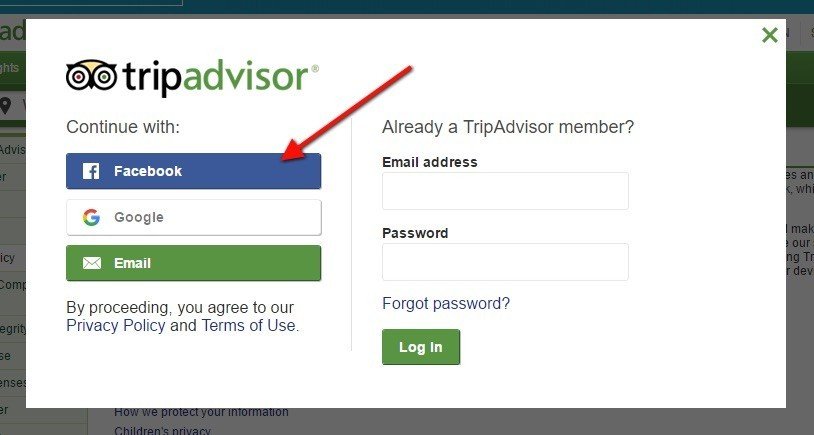
However, this is not enough on its own. You still need acceptance terms in your Terms & Conditions agreement.
This is often as simple as stating in your introduction, "Use of our services constitutes acceptance of the Terms and Conditions."
[email protected] explains that use of its service creates agreement to its terms. Users who do not wish to follow the T&C should not use the service:
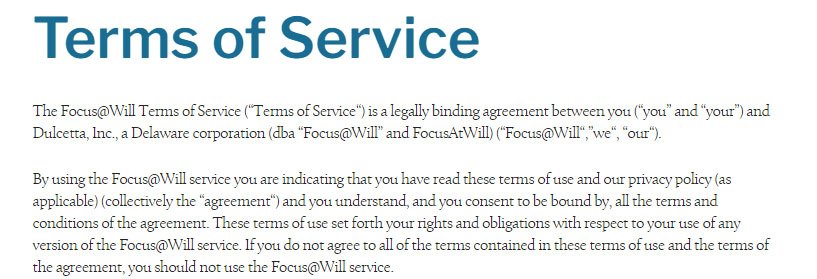
Pinterest takes a similar approach with a better plain-language explanation:

Basically, the idea you need to get across here is that use of your services means acceptance of the terms outlined in your agreement. This is the basis that makes your Terms & Conditions enforceable.
Privacy Practices
Unless you don't collect any personal information, you'll likely draft a separate Privacy Policy.
Privacy Policies are required throughout the E.U., Canada, and Australia, as well as the state of California in the U.S.
This is definitely a "better safe than sorry" situation which is why websites and apps that ask for nothing more than names and birthdates will still maintain a Privacy Policy.
You'll also mention privacy in your Terms & Conditions. This works as reassurance and includes privacy concerns with your rules of use and conduct.
Describing how you store and utilize user data provides transparency to your customers and protects you from liability.
For most developers, this includes merely a reference and link to the Privacy Policy. RescueTime keeps this provision brief:

Car2go takes a similar approach in its Terms & Conditions agreement on memberships:

If you are writing your own Terms & Conditions, this simple approach is likely the best approach to drafting this section.
You're more likely to maintain consistency with your company's Privacy Policy which also helps with enforcing your agreements.
Limitation of Liability or Disclaimers
You want at least a general limitation of liability. Without it, your users could pursue damages for shutdowns, viruses, and failure of your app, website or software.
Even if you don't anticipate any issues, it's often what you never expected that gets your company in legal trouble.
Generally, you want it clear to your users that you will not be responsible for damages arising from use of your service. You'll also want to inform users that their use of your app or website may come with risk, even if that possibility is small.
[email protected] presents a brief limitation of liability in its Terms & Conditions agreement:
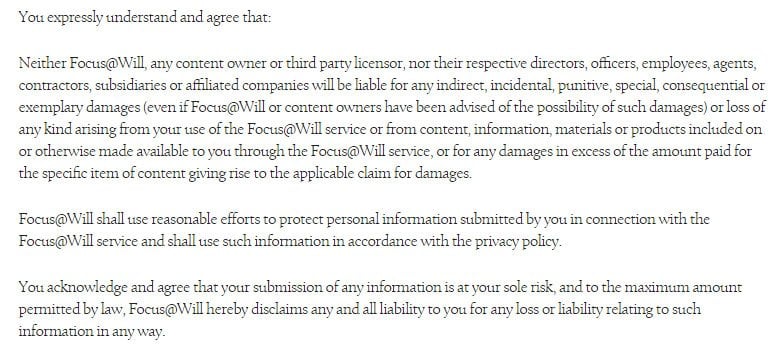
Other companies, like ZenDesk, prefer to place emphasis on these limits using all capital letters. General waivers like these often work for your agreement too as they apply to many products and situations:
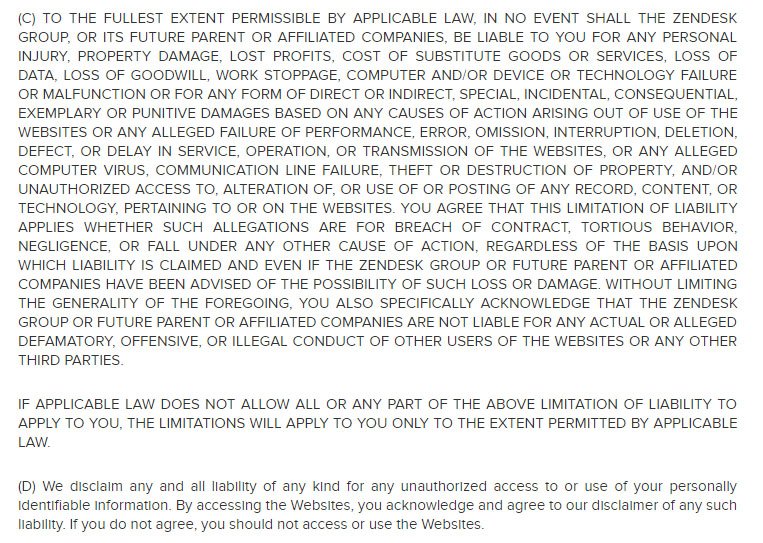
If your service (app or website) is specialized with a good chance that users may misinterpret your intentions, specific disclaimers are also helpful.
WebMD provides general medical information, but the information is not intended as medical advice. It includes this specific disclaimer in its T&C to prevent misunderstanding:
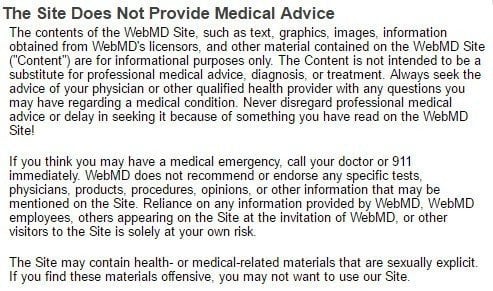
Before relying on a general liability limitation, carefully consider what you offer.
There may be room for misinterpretation that could lead to liability. Include those concerns in this section to reduce that possibility, even if you feel the risk is low.
Intellectual Property Rights
Any user with access to your site will also have access to your intellectual property. This includes trademarks, copyrighted material, proprietary algorithms, and other elements that help your website, app or service uniquely yours.
Using your intellectual property without permission or a license is infringement and is actionable under law. If a user does this, you want the ability to pursue an infringement claim but also terminate that user's access to your services.
The intellectual property section in a Terms & Conditions covers this situation.
If your app or website does not have a long international reach or your company owns little in the way of intellectual property, you can usually get away with a standard statement.

Small companies that own several trademarks or copyrights or large companies with an international reach prefer more detail in this section.
Business Insider is one example of this approach. Between website trademarks and copyright ownership in articles, it offers this extensive intellectual property section in its Terms & Conditions agreement:
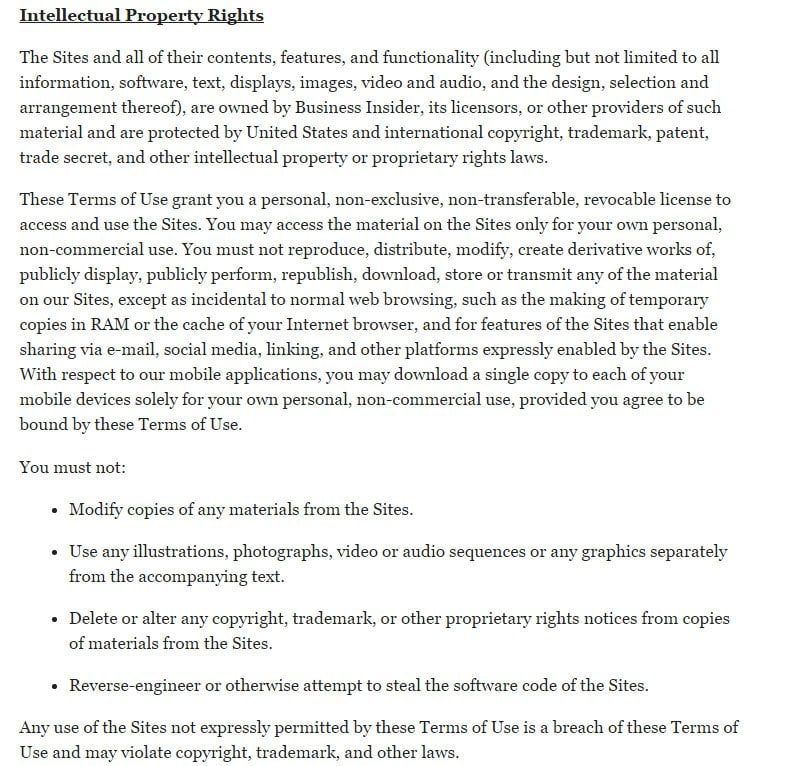
A general statement covers most of your intellectual property. However, if the risk of users misappropriating it is high, consider adding specific restrictions in this section.
Advertising and Endorsements
If you host advertisements from third parties, you should disclose those relationships even if you are not paid for them.
Besides revealing your connections to advertisers, you also want to waive any liability that may be connected to those ads. The use of user information in advertisements is reserved primarily for the Privacy Policy but you can still disclose your relationships and waive liability in the Terms & Conditions agreement.
Pandora keeps it brief with this statement:
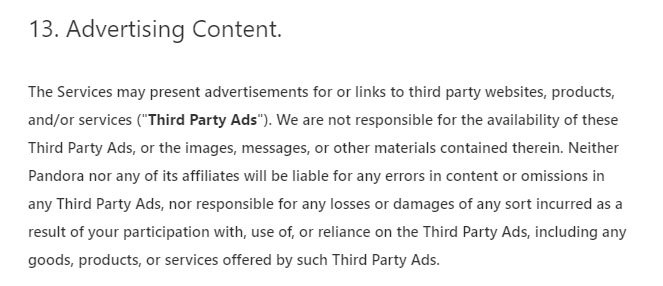
If your app or website does not display ads from third parties, you won't need to address this issue.
Use TermsFeed Terms & Conditions Generator to generate a custom Terms & Conditions for your business.
Payment Terms
Subscription services (like SaaS apps) must include payment terms in their Terms & Conditions.
This allows you to terminate service for non-payment and puts customers on notice that you require payment information. These provisions also indicate the frequency of payment and whether you offer monthly, quarterly or annual payment plans.
This section does not have to include payment amounts. You likely have a page with subscription plans and their cost, so this is not necessary information for the Terms & Conditions.
Besides, this removes the obligation to change your Terms & Conditions agreement when you decide to adjust your prices or offer a new subscription plan.
The payment terms often explain how and when payment is due. IndieCity discusses currency and its preference for credit or debit cards:
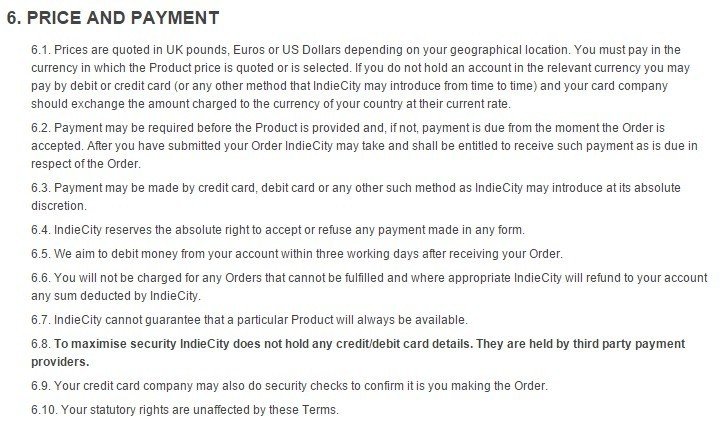
If you offer a free trial and payment incurs when that trial expires, you can address that issue. Basecamp addresses this issue as well as upgrading and downgrading plans. There is also a link to the refund policy:
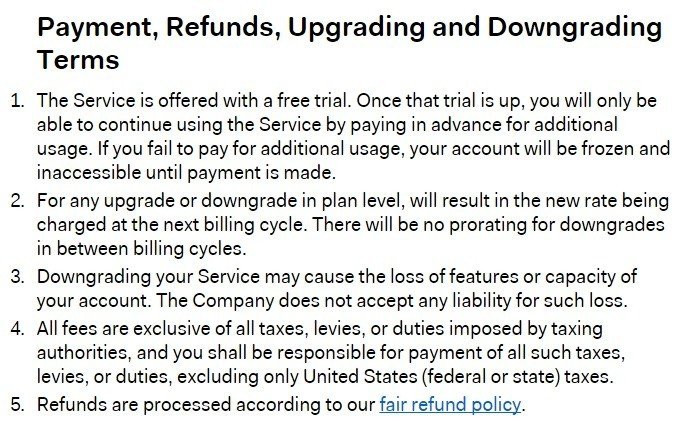
In the least, you should include the frequency of payments and acceptable payment methods listed in this section. That will allow you to terminate users from your services for non-payment. If you do not charge regular subscription fees, you do not need this section.
Termination
The termination clause contains your ability to enforce the Terms & Conditions. It may stand on its own or list violations that result in termination.
If you're concerned primarily with your intellectual property and your website or app does not support interaction between users, a general termination clause is sufficient. However, trends suggest that companies prefer specific termination language.
Before it updated its Terms & Conditions agreement, Dropbox adopted a general approach to terminating accounts. It explains that users may stop using services at any time and a violation of the T&C results in account termination:

Since February 2017, Dropbox changed its termination clause to separate reasons by number and offer specific details on what will trigger the termination an account:
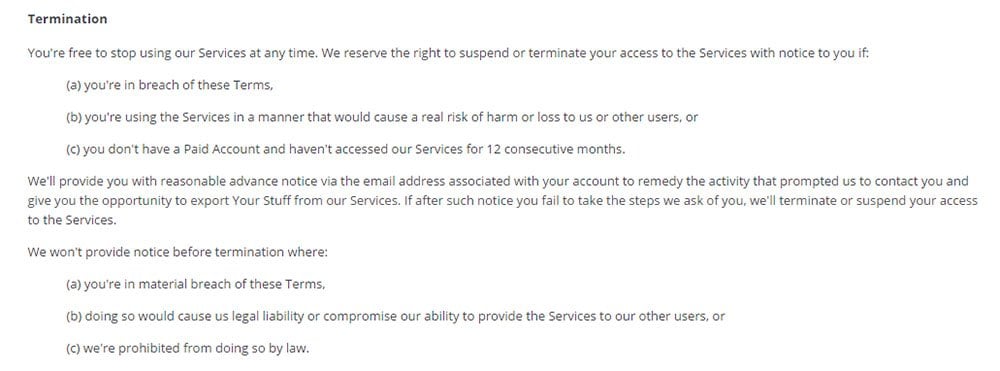
If there are user behaviors that are not tolerated, those should also be listed in your termination clause. Envato Market includes the violation of community values as grounds for termination:
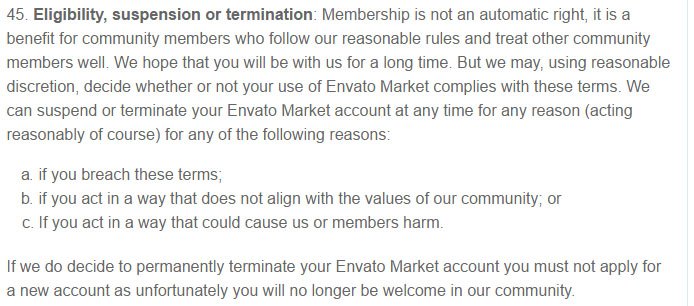
A general termination clause remains legally sufficient. This may be a good option for the short term if this is the first Terms & Conditions you write or if your app or website is new. Eventually, you may want to make it more specific, especially if you happen to come across an unusual situation that you want to explicitly acknowledge.
Notification of Changes
Your Terms & Conditions agreement will change as you learn more about your market and encounter new issues. This is common with all developers and users generally expect it.
You still need to preserve your authority to make these changes and that happens through your Terms & Conditions. It's typically just a general statement indicating that you may change the Terms & Conditions and users will receive a notification.
You can put this under a "General" in your Terms & Conditions or give it its own heading. This is typically put at the end of the agreement.
Twitter places this explanation under a final "General" heading:

Dropbox likes to give specific reasons why its Terms & Conditions agreement may change. It also offers reassurance that users will be notified if the changes affect their rights and use of the service:

This provision should be in every Terms & Conditions agreement. Omitting it will likely not compromise your right to change your agreements but you will lack legal standing if a user takes action against you due to a change. Even a general statement like Twitter's clause is better than skipping this entirely.
Contact Information
End your Terms & Conditions with an invitation for users to contact you if they need clarification of the terms you have in your agreement. This is not present for all agreements but it's recommended as it encourages understanding with your users.
This can be as simple as "Have questions, contact us" and offering an email address or telephone number. Pandora keeps this short but allows users to communicate through a support team link:

IndieCity offers an email address and even a turnaround time for answering questions:

Consider setting up a separate email address for these inquiries. That allows for better customer service and it is easier to designate employees to address the questions.
Terms & Conditions in Plain Language
The Terms & Conditions agreement is considered a dense document that's difficult to navigate and understand. In some cases, that's true.
However, it's becoming more common to find the Terms & Conditions written in plain language or with summary notes provided along with it. This works in your favor. Vague documents can be thrown out in court and construed against you.
Use TermsFeed Terms & Conditions Generator to generate a custom Terms & Conditions for your business.
Pinterest offers a good example if you believe this can work for you. While the Terms & Conditions has the typical provisions, it also offers notes in the margin:
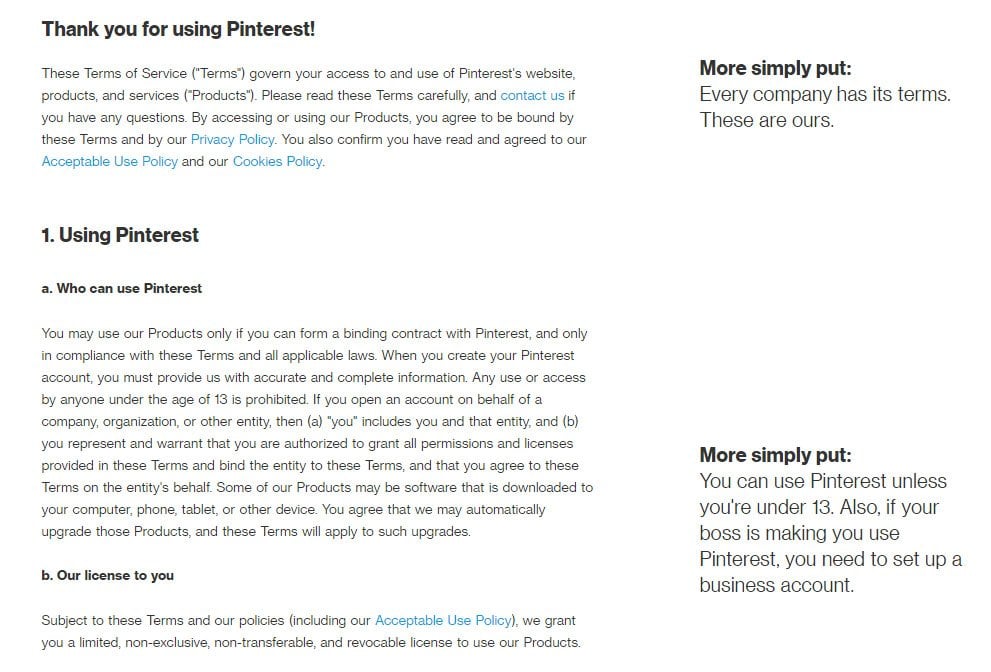
The Terms & Conditions is the best way to protect your company from liability, manage user behavior, and create reasonable expectations. Using these steps, you can write a basic Terms & Conditions that offers all of these benefits.
How To Create A Terms And Conditions Page
Source: https://www.termsfeed.com/blog/write-terms-conditions/
Posted by: blancharddeve1941.blogspot.com

0 Response to "How To Create A Terms And Conditions Page"
Post a Comment